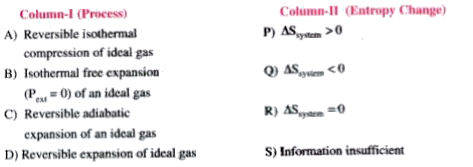As per second law of thermodynamics a process taken place spontaneously if and only if the entropy of the universe increases due to the process. Change in entropy is given by
ΔS=QrevT
A gas CV=(0.2T)CalK−1. What is the change in its entropy when one mole of it is heated from 27∘C to 127∘C at constant volume ?Solution in Telugu
20cal K−1mol−1
15cal K−1mol−1
35cal K−1mol−1
25cal K−1mol−1
The correct Answer is:A
ΔS=T2∫T1nCVdTT+V2∫V1pdvT
For the given condition
ΔS=T2∫T1nCvdTT=0.2TTdT
=02(T2−T1)=20 cal/mol- k
Topper's Solved these Questions
- BOOK - AAKASH SERIESCHAPTER - CHEMICAL THERMODYNAMICSEXERCISE - LECTURE SHEET (EXERCISE-III) (LEVEL - II (ADVANCED) MATRIX MATCHING TYPE QUESTIONS)2videos
CHEMICAL THERMODYNAMICS
- BOOK - AAKASH SERIESCHAPTER - CHEMICAL THERMODYNAMICSEXERCISE - LECTURE SHEET (EXERCISE-III) (LEVEL - II (ADVANCED) INTEGER TYPE QUESTIONS)5videos
CHEMICAL THERMODYNAMICS
- BOOK - AAKASH SERIESCHAPTER - CHEMICAL THERMODYNAMICSEXERCISE - LECTURE SHEET (EXERCISE-III) (LEVEL - II (ADVANCED) MORE THAN ONE CORRECT ANSWER TYPE QUESTIONS)5videos
CHEMICAL THERMODYNAMICS
- BOOK - AAKASH SERIESCHAPTER - CHEMICAL THERMODYANMICS EXERCISE - Questions For Descriptive Answers28videos
CHEMICAL THERMODYANMICS
- BOOK - AAKASH SERIESCHAPTER - ELECTRON MIGRATION EFFECTS EXERCISE - QUESTIONS FOR DESCRIPTIVE ANSWERS10videos
ELECTRON MIGRATION EFFECTS
Similar Questions
 01:02View Solution
01:02View SolutionIn how many of the following entropy increases?
(a)N2(g)+3H2(g)→2NH3(g)(b)PCl5(g)→PCl3(g)+Cl2(g)(c)H2O(s)→H2O(g)(d)H2O(l)→H2O(g)(e)2NaHCO3(s)→Na2CO3(s)+H2O(g)+CO2(g)(f)NH2CO2NH4(s)→2NH3(g)+CO2(g)(g)H2O(l)→H2O(s)(h)CO2(s)→CO2(g)02:52View SolutionAll the antural processes in this universe produce
02:03View SolutionHow does heat of neutralisation value change with the chemical nature of acid and base?
02:08View SolutionHyperconjugation effect is also termed as 'no bond resonance'. Why?
03:53View SolutionEntropy ( S ) is a thermodynamic variable like pressure P , volume V and temperature T . Entropy of a thermodynamic system is a measure of disorder of molecular motion. Greater is disorder , greater is entropy. Change in entropy of a thermodynamic system is the ratio of heat supplied to absolute temperature.In an adiabatic reversible process, entropy remains constant while in any irreversible process entropy increases. In nature the processes are irreversible , therefore entropy of universe is continuoulsy increasing. The unit of entropy in S-I system is -
03:03View SolutionEntropy ( S ) is a thermodynamic variable like pressure P , volume V and temperature T . Entropy of a thermodynamic system is a measure of disorder of molecular motion. Greater is disorder , greater is entropy. Change in entropy of a thermodynamic system is the ratio of heat supplied to absolute temperature.In an adiabatic reversible process, entropy remains constant while in any irreversible process entropy increases. In nature the processes are irreversible , therefore entropy of universe is continuoulsy increasing. When milk is heated , its entropy :
01:37View SolutionEntropy ( S ) is a thermodynamic variable like pressure P , volume V and temperature T . Entropy of a thermodynamic system is a measure of disorder of molecular motion. Greater is disorder , greater is entropy. Change in entropy of a thermodynamic system is the ratio of heat supplied to absolute temperature.In an adiabatic reversible process, entropy remains constant while in any irreversible process entropy increases. In nature the processes are irreversible , therefore entropy of universe is continuoulsy increasing. After a long-long time, the energy available for work done will be :
03:53View SolutionExplain change in entropy of a system during a reversible process Delta S = (q_(rev))/(T)
04:08View SolutionAs per second law of thermodynamics a process taken place spontaneously if and only if the entropy of the universe increases due to the process. Change in entropy is given by
ΔS=QrevT
What is the change in entropy of the universe due to the following reaction occuring at 27∘C ?
A+2B→C+2D,ΔH=+1.8kJmol−1
Molar entropy values of A, B, C and D are 1,2,3 and 4JK−1mol−1 respectively.01:06View SolutionAs per second law of thermodynamics a process taken place spontaneously if and only if the entropy of the universe increases due to the process. Change in entropy is given by
ΔS=QrevT
A gas CV=(0.2T)CalK−1. What is the change in its entropy when one mole of it is heated from 27∘C to 127∘C at constant volume ?01:07View SolutionThe thermodynamic property that measures the extent of molecular disorder is called entropy. The direction of a spontaneous process for which the energy is constant is always the one that increases the molecular disorder. Entropy change of phase transformation can be calculated using Trouton's formula (ΔS=ΔHT). In the reversible adiabatic process, however, ΔS will be zero. The rise in temperature in isobaric and isochoric conditions is found to increase the randomness or entropy of the system. ΔS=2.303Clog(T1/T2),(C=CPorCV)
The entropy change in an adiabatic process is02:09View SolutionAs per second law of thermodynamics a process taken place spontaneously if and only if the entropy of the universe increases due to the process. Change in entropy is given by
ΔS=QrevT
What is the change in entropy of the universe due to the following reaction occuring at 27∘C ?
A+2B→C+2D,ΔH=+1.8kJmol−1
Molar entropy values of A, B, C and D are 1,2,3 and 4JK−1mol−1 respectively.02:43View Solutionरुद्धोष्म प्रक्रम में ।
03:46View SolutionFor a sample of n mole of a perfect gas at constant temperature T (K) when its volume is changed from V1 to V2 the entropy change is given by
02:14View Solution

